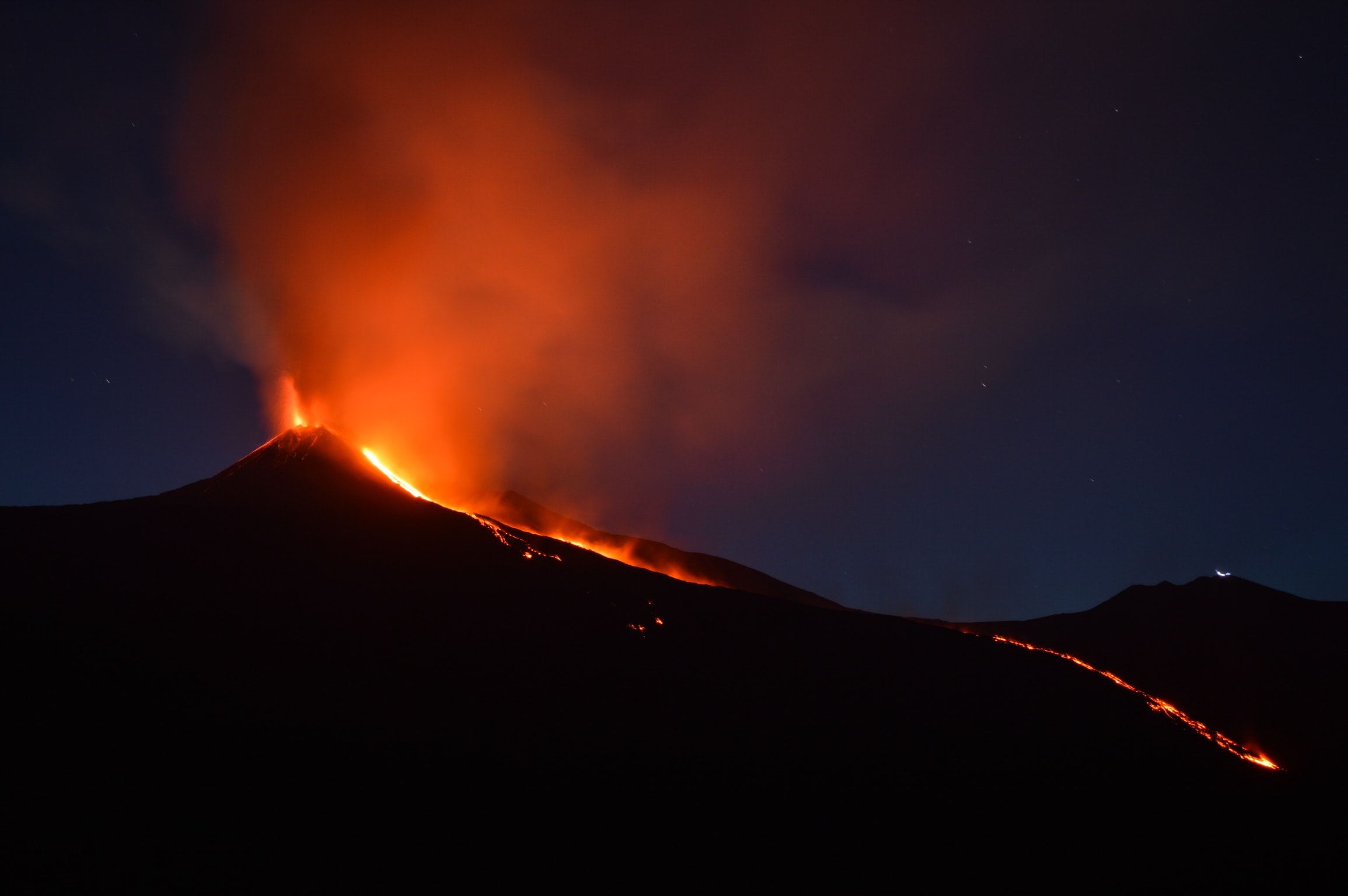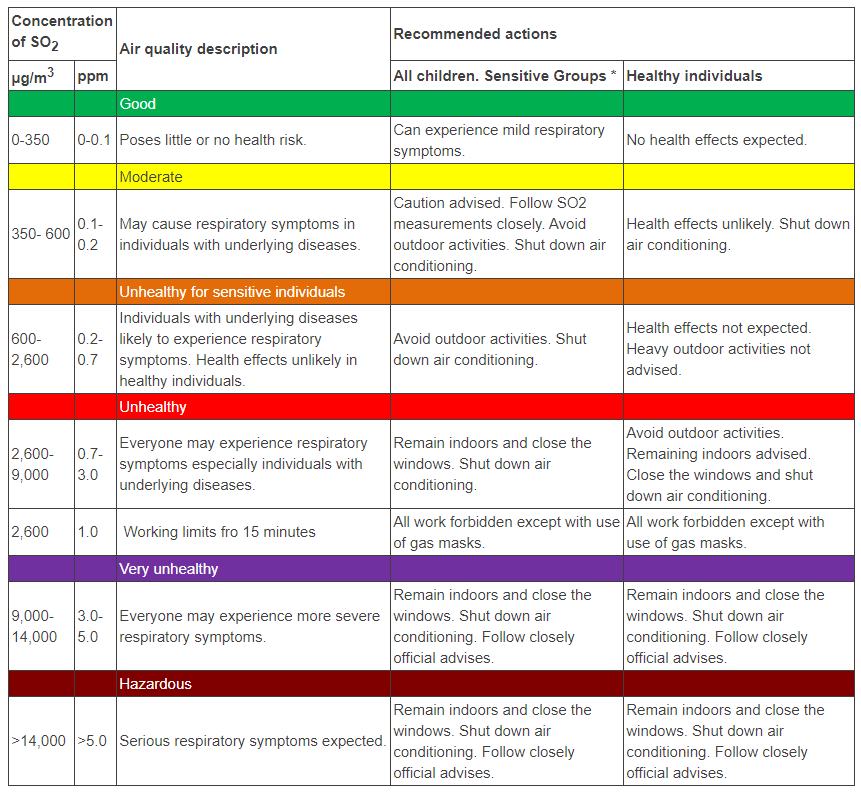Vinna við nýjar heimasíður Umhverfis- og orkustofnunar og Náttúruverndarstofnunar er í gangi. Heimasíða Umhverfisstofnunar er virk á meðan vinnunni stendur. Information in English
Air pollution during a volcanic eruption

Volcanic gases with possible effect on human health are released into the atmosphere during volcanic eruptions.
The most abundant gases are:
- carbon dioxide (CO2)
- sulfur dioxide (SO2)
Other substances such are also released but in smaller amounts:
- hydrogen sulfide (H2S)
- hydrogen(H2)
- carbon monoxide (CO)
- hydrogen chloride (HCl)
- hydrogen fluoride (HF)
- helium (He)
The human health effect is mainly caused by SO2, the most common symptoms are irritation in eyes, throat and respiratory tract and people can experience difficulties in breathing in high concentrations of SO2.
Persons with asthma, bronchitis, emphysema and heart diseases are more sensitive compared to healthy people and develop symptoms at lower concentrations compared to others. They are advised to have their respiratory medication available.
It is wise to use the same recommendations for children as for people with underlying respiratory diseases, although no reliable data on children and SO2 is available.
It is therefore of importance to monitor the concentration of SO2 in the atmosphere. The Icelandic Met Office measures SO2 at the eruption site and develops daily forecasts on SO2 concentration in the atmosphere that are based on SO2 measurements and weather conditions. The purpose is to alert the public in areas where high concentration can be expected and the results are published on The Icelandic Met Office home page.
The amount of SO2 that is released in the eruption is an important factor, but the wind direction and force also have a large impact on the concentration of SO2 in the atmosphere.
It should be reiterated that it is impossible to foresee all circumstances and it is therefore crucial to respond to unexpected events. The general public is encouraged to respond if an unexpected plume appears, stay indoors, close windows and turn of the air conditioning if they experience symptoms from the plume.
The Environmental Agency of Iceland measures SO2 in various locations, information is available at the home page for the agency.
Further information on symptoms caused by SO2 at different concentration levels is available in this table.
Health Effects of Short-term Volcanic SO2 Exposure and Recommended Actions
The colors in the table indicate the average concentration of SO2 for 10-15 minutes. The health effects depend both on the time of SO2 exposure and SO2 concentration. Health effect limits are defined as the average concentration of SO2 of 350 µg/m3 for one hour or 125 µg/m3 for 24 hours.

*Children and adults with pre-existing bronchial asthma, bronchitis, emphysema and/or heart diseases.
Working limits:
If the average SO2 concentration exceeds 1.300 µg/m3 for 8 hours, the working period has to be shortened proportionally to the SO2 concentration or appropriate gas masks have to be used. It the average SO2 concentration exceeds 2.600 µg/m3 for 15 minutes, all work has to be stopped or appropriate gas masks have to be used.
See Administration of Occupational Safety and Health.
General recommendations:
Individuals with pre-existing pulmonary and heart diseases are encouraged to have their medications readily available.
Breathe with your nose as much as possible and avoid physical exercise outdoors during heavy pollution as this will reduce the amount of SO2 reaching the lungs.
Remaining indoors with windows closed and air conditioning shut down provides a significant protection against the pollution.
Further measures:
During heavy SO2 pollution and if you experience respiratory difficulties, even indoors, you can take the following measures to reduce the concentration of SO2 in the air by preparing a simple air cleaning device.
Take 5 grams of ordinary baking soda and dilute it in 1 liter of water.
Soak a piece of cloth, e.g. a dish towel, a thin towel or an old fashioned flat cloth diaper in the solution.
Wring most of the water from the cloth so that no water leaks from it.
Fasten the damp cloth on to some sort of frame, e.g. a drying rack, and fasten it on all sides of the rack, for instance by means of clothespins.
Place the rack in the room where the air is to be cleaned.
The cloth must be kept damp if it is to continue to work as intended and to keep its moisture you should spray it with water, e.g. from a flower spray bottle.
In order to increase the effect let a table top fan blow air on the cloth. NB! The fan is an electric tool, so take care that moisture from the cloth or the spray bottle does not reach the fan. The fan must be situated at a safe distance from the cloth, no closer than about two meters. By no means spread the cloth over the fan itself.
If a fan is not available the cloth will still be effective, particularly if placed close to wall heaters since there is more air flow in the proximity of heaters than in other places in the home. NB! There is no need to spread the cloth over the heater, it is sufficient to place it on a rack by the side of it. Be careful with electric heaters as the air flow around them must not be restricted and they must never be covered.
If a high concentration of SO2 continues for a long period the cloth must be rinsed in running water two times a day and placed in the baking soda solution.
High concentration of SO2 outdoors
If people must stay outdoors during a high concentration of SO2 that causes respiratory difficulties, it is helpful to hold a damp cloth to your mouth and nose as this will reduce the amount of SO2 in the air you inhale. A cloth soaked in a baking soda solution, as described above, is still more effective, however. Please note that water makes the cloth less permeable so that breathing through it is more difficult. This can prove difficult or even dangerous for weak individuals.
You can also use a traditional dust mask that can be obtained in hardware stores and soak it in baking soda solution. Dust masks, however, are so impermeable that the added water increases their resistance and makes them hard to breathe through. The mask must therefore be fully dried before use, which takes about 24 hours.
ATTENTION: Damp cloths and dust masks that have been soaked in baking soda solution only work for a short while (several minutes) and are not nearly as effective as gas masks. This is therefore not a long lasting measure and cannot at all be used very close to the eruption site. In that area, the use of gas masks is the only effective way of reducing SO2 in inhaled air. Gas masks, however, are not widely available and their use is not advised unless in circumstances where the SO2 concentration is very high as in the proximity of an eruption site, and according to official recommendations.